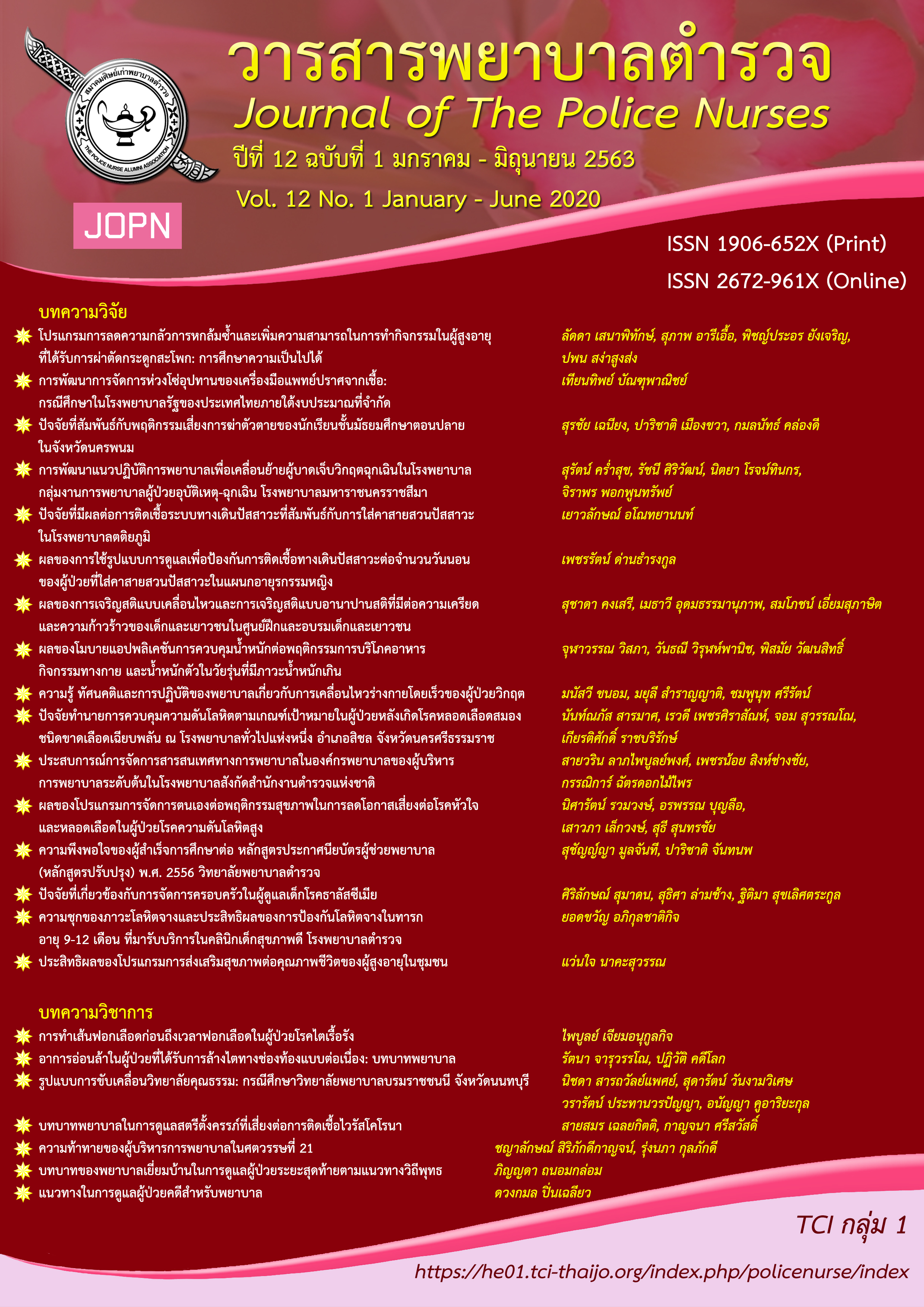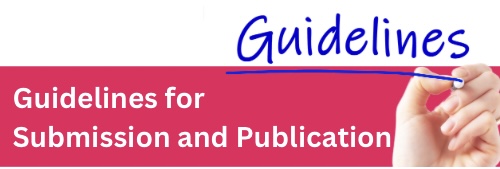PREDICTING FACTORS OF THE TARGETED BLOOD PRESSURE CONTROL AMONG PATIENTS WITH POST-ACUTE ISCHEMIC STROKE AT A GENERAL HOSPITAL, SICHON DISTRICT, NAKHON SI THAMMARAT
Keywords:
recurrence stroke risk, blood pressure, medication adherence, acute ischemic strokeAbstract
This retro-prospective study aimed to describe the targeted blood pressure control rate and determine predicting factors of post-stroke blood pressure control among 192 eligible patients with post-acute ischemic strokes at a General Hospital, Sichon District, Nakhon Si Thammarat province discharging from 2017 to 2018. Secondary data analysis from hospital health profile with the patient or caregiver interviewing was employed using seven questionnaires including 1) a Sociodemographic questionnaire, 2) health condition and illness records, 3) the Essen stroke risk score, 4) a risk assessment for recurrent stroke, 5) blood pressure record 6) a modified medication adherence scale (CVI = .87, α = .90), and 7) a medication use questionnaire. Descriptive statistics and multiple logistic regression analysis were applied to calculate the crude OR value at a 95% CI.
Most of the patients in this study were men (61.6%) who had an average age of 65.4±14.8 years. The results of the targeted blood pressure control analysis found that the group under the age of 60 (25%), the group older than 60 years (36.3%, and the group with diabetes (27.9%) had achieved less blood pressure control than 140/90 mm Hg. Receiving Calcium Chanel Blockers (OR= 2.94, p = .027), medication adherence of Antihypertensive (OR = 9.43, p = .024), medication adherence of Antiplatelet (OR = 4.06, p= .020), and medication behavior (OR = 3.43, p = .010) were statistically significant predictors of targeted blood pressure control with19.4% of explained variance (p < .05). From the findings, nurse and health care provider should promote medication adherence of Antiplatelet and Antihypertensive among the patients to improve their blood pressure control and lower rate of recurrent stroke, especially in the elderly.
Downloads
References
Alexander, R. W. (1995). Hypertension and the pathogenesis of atherosclerosis. Hypertension, 25(2), 155–161.
Boan, A. D., Lackland, D. T., & Ovbiagele, B. (2014). Lowering of blood pressure for recurrent stroke prevention: Topical Review. Stroke, 45(8), 2506-2513.
Bravata, D. M., Daggy, J., Brosch, J., Sico, J. J., Baye, F., Myers, L. J., . . . Arling, G. (2018). Comparison of risk factor control in the year after discharge for ischemic stroke versus acute myocardial infarction. Stroke, 49, 296–303.
Brewer, L., Mellon, L., Hall, P., Dolan, E., Horgan, F., Shelley, E., . . . Williams, D. (2015). Secondary prevention after ischaemic stroke: The ASPIRE-S study. BMC Neurology, 15(216), 1-8.
Bushnell, C. D., Olson, D. M., Zhao, X., Pan, W., Zimmer, L. O., Goldstein, L. B., . . . AVAIL Investigators. (2011). Secondary preventive medication persistence and adherence 1 year after stroke. Neurology, 77(12), 1182–1190.
CAPRIE Steering Committee. (1996). A randomized, blinded, trial of clopidogrel versus aspirin in patients at risk of ischemic events (CAPRIE). Lancet, 348(9038), 1329–1339.
Casolla, B., Moulin, S., Kyheng, K., Hénon, H., Labreuche, J., Leys, D., . . . Cordonnier, C. (2019). Five-year risk of major ischemic and hemorrhagic events after intracerebral hemorrhage. Stroke, 50(5), 1100-1107.
Chen, G. J., & Yang, M. S. (2013). The effects of calcium channel blockers in the prevention of stroke in adults with hypertension: A meta-analysis of data from 273,543 participants in 31 randomized controlled trials. PloS One, 8(3),e57854.
Costa, R. S., & Nogueira, L. T. (2008). Family support in the control of hypertension. Revista Latino-Americana de Enfermagem. 16(5), 871-876.
Eckel, R. H., Jakicic, J. M., Ard, J. D., de Jesus, J. M., Houston, M. N., . . .Tomaselli, G. F., (2014). American College of Cardiology/American Heart Association Task Force on Practice Guidelines 2013 AHA/ACC guideline on lifestyle management to reduce cardiovascular risk: A report of the American College of Cardiology/American Heart Association Task Force on Practice Guidelines. Circulation, 129(25 Suppl 2), S76–S99.
James, P. A., Ortiz, E., Carter, B. L., Cushman, W. C., Dennison-Himmelfarb, C., Handler, J., Lackland, D. T., . . . Ortiz, E. (2014). Evidence-based guideline for the management of high blood pressure in adults: (JNC8). JAMA, 311(5), 507-520. doi:10.1001/jama.2013.284427.
Kohok, D. D., Sico, J. J., Baye, F., Myers, L., Coffing, J., Kamalesh, M., & Bravata, D. M. (2018). Post-stroke hypertension control and receipt of health care services among veterans. The Journal of Clinical Hypertension, 20(2), 382–387.
Krueger, H., Lindsay, P., Cote, R., Kapral, M.K., Kaczorowski, J., & Hill, M.D. (2012). Cost avoidance associated with optimal stroke care in Canada. Stroke, 43(8), 2198–2206.
Kumar, S. (2106). Hypertension and ischemic stroke. Hypertension and Ischemic Stroke, 2(1), 39–43.
Lijing, L. Y., Chaoyun, L., Jie, C., Jaime, M., Rong, L., Janet, B., . . . Wu, Y., (2016). Prevention, management, and rehabilitation of stroke in low- and middle-income countries. eNeurological Science, 2, 21-30.
Morisky, D. E., Ang, A., Krousel-Wood, M., & Ward, H. J. (2008). Predictive validity of a medication adherence measure in an outpatient setting. The Journal of Clinical Hypertension, 10(5), 348–354.
Nidhinandana, S., Ratanakorn, D., Charnnarong, N., Muengtaweepongsa, S., & Towanabut, S. (2014). Blood pressure control among stroke patients in Thailand-The i-STROKE study. Journal of Stroke and Cerebrovascular Diseases, 23(3), 476–483.
Nijasri, C. S. (2014). Stroke epidemiology in Thailand. Journal of Stroke, 16(1), 1-7.
Oftedal, Å., Gerdts, E., Waje-Andreassen, U., Fromm, A., Naess, H., Linde, A., . . . Saeed, S. (2018). Prevalence and covariates of uncontrolled hypertension in ischemic stroke survivors: The Norwegian stroke in the young study. Blood Press, 27(3), 173–180.
Pandian, J. D., Felix, C., & Kaur, P. (2015). Family-led rehabilitation after stroke in India: The attend pilot study. International Journal of Stroke, 10(4), 609–614.
Poon, M. T., Fonville, A. F., & Al-Shahi, S. R. (2014). Long-term prognosis after intracerebral haemorrhage: Systematic review and meta-analysis. Journal of Neurology, Neurosurgery, and Psychiatry, 85, 660–667.
Raju, R. S., Sarma, P. S., & Pandian, J. D. (2010). Psychosocial problems, quality of life, and functional independence among Indian stroke survivors. Stroke, 41(12), 2932–2937.
Rosendorff, C., Lackland, D. T., Allison, M., Aronow, W. S., Black, H. R., Blumenthal, R. S., . . . White, W. B. (2015). Treatment of hypertension in patients with coronary artery disease: A scientific statement from the American heart association, American College of Cardiology, and American Society of Hypertension. Journal of the American College of Cardiology, 65, 1998–2038.
Roumie, C. L., Ofner, S., Ross, J. S., Arling, G., Williams, L. S., Ordin, D. L., . . . Bravata, D. M. (2011). Prevalence of inadequate blood pressure control among Veterans after acute ischemic stroke hospitalization. Circulation: Cardiovascular Quality Outcomes, 4(4), 399–407.
Roumie, C. L., Zillich, A. J., Bravata, D. M., Jaynes, H. A., Myers, L. J., Yoder, J., & Cheng, E. M. (2015). Hypertension treatment intensification among stroke survivors with uncontrolled blood pressure. Stroke, 46, 465-470.
Sarfo, F. S., Mobula, L. M., Plange-Rhule, J., Ansong, D., & Ofori-Adjei, D. (2018). Incident stroke among Ghanaians with hypertension and diabetes: A multicenter, prospective cohort study. Journal of the Neurological Sciences, 395, 17–24.
Seesawang, J., & Rungnoei, N. (2016). Nursing care for stroke patients: Strategies towards Patient-Centered Care Prachomklao College of Nursing, Phetchabu Ri Province. Journal of Nursing Science, 34(3), 10-18.
Shaik, S., Wang, Z., Inuzuka, H., Liu, P., & Wei, W. (2013). Chapter 1: Endothelium aging and vascular diseases. In Tech, senescence and senescence-related disorders. Retrieved from https://cdn.intechopen.com/pdfs/43109/InTechEndothelium_aging_and_vascular_diseases.pdf.
Shekhar, S., Liu, R., Travis, O. K., Roman, R. J., & Fan, F. (2017). Cerebral autoregulation in hypertension and ischemic stroke: A mini review. Journal of pharmaceutical sciences and experimental pharmacology, 1, 21-27.
Thai Hypertension Society. (2019). 2019 Thai Guidelines on the treatment of hypertension. Retrieved from http://www.thaihypertension.org/files/HT%20guideline%202019.with%20watermark.pdf.
Weimar, C., Diener, H. C, Alberts, M. J., Steg, P. G., Bhatt, D. L, Wilson, P. W., . . . Rother, J. (2009). The essen stroke risk score predicts recurrent cardiovascular events. Stroke, 40(2), 350-354.
Whelton, P. K., Carey, R. M., Aronow, W. S., Ovbiagele, B., Casey, D. E., Collins, K. J, . . . Wright, J. K. (2017). 2017ACC/AHA/AAPA/ABC/ACPM/AGS/APhA/ASH/ASPC/ NMA/PCNA guideline for the prevention, detection, evaluation, and management of high blood pressure in adults. Journal of The American College of Cardiology, 71(19), e127-248.
Williams, B., Mancia, G., Spiering, W., Rosei, E. A., Azizi, M., Burnier, M., . . . Desormais, I. (2018). 2018 ESC/ESH guidelines for the management of arterial hypertension. European Heart Journal, 39(33), 3021-3104.
World Health Organization (WHO). (2016). ICD-10 version: 2016. Retrieved from https://icd.who.int/browse10/2016/en#/I60-I69.
Xu, J., Tao, Y., Li, H., Gu, H., Xie, X., Meng, X., . . . Wang, Y. (2017). Different levels of blood pressure, different benefit from dual antiplatelet therapy in minor stroke or TIA patients. Science Report, 7, 1-6.
Zhang, W. W., Cadihac, D. A., O’Callaghan, C., & Dewey, H. M. (2009). Hypertension and TIA. International Journal of Stroke, 4(3), 206-214.
Downloads
Published
How to Cite
Issue
Section
License
ผลงานที่ได้ตีพิมพ์แล้วจะเป็นลิขสิทธิ์ของวารสารพยาบาลตำรวจ















